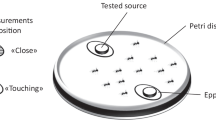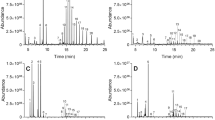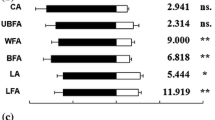Abstract
Choice bioassays were used to determine repellency of homologous n-alkanes (C8H18–C21H44) to spider mites. When tested at 400 μg/cm2, the C15–C19 alkanes were highly repellent; the C16 n-alkane, n-hexadecane, was most repellent. Subsequently the EC50 values, the concentration at which 50% of the mites were repelled, were determined for the C15–C19 n-alkanes and their analogous 1-n-alkenes (C15H30–C19H38). The EC50 value for 1-heptadecene, the C17 1-n-alkene, was the lowest observed. Except for the 17-carbon hydrocarbons, the EC50 values for the n-alkanes were less than those for their analogous 1-n-alkenes. Depending on the compounds evaluated, there was as much as a six-fold difference of repellency between an n-alkane its analogous 1-n-alkene. Thus, the bioassay has sufficient sensitivity to detect behavioral differences associated with the presence or absence of a single double bond. The EC50 values for the most repellent hydrocarbons were similar to that reported for 2,3-dihydrofarnesoic acid, a naturally occurring repellent isolated from trichome secretions of a wild tomato, Solanum habrochaites, and also were similar to concentrations used to evaluate arthropod repellents. Consequently, this bioassay may be useful for providing a better understanding of the relationships between structures and activities of natural products that are repellent to spider mites.


Similar content being viewed by others
References
Anonymous (2008) Knovel critical tables, 2nd edn, Knovel. http://knovel.com/web/portal/browse/display?_EXT_KNOVEL_DISPLAY_bookid=761&VerticalID=0. Accessed 24 Dec 24 2010
Anonymous (2010) Interactive physprop database demo. SRC. http://www.syrres.com/what-we-do/databaseforms.aspx?id=386. Accessed 24 Dec 2010
Blomquist G, Bagneres A-G (eds) (2010) Insect hydrocarbons—biology, biochemistry and chemical ecology. Cambridge University Press, Cambridge
Bowers W, Nault L, Webb R, Dutky S (1972) Aphid alarm pheromone: isolation, identification, synthesis. Science 177:1121
Breeden D, Young T, Coates R, Juvik J (1996) Identification and bioassay of kairomones for Helicoverpa zea. J Chem Ecol 22:513–539
Carlson D, Schlein Y (1991) Unusual polymethyl alkenes in tsetse flies acting as abstinon in Glossina morsitans. J Chem Ecol 17:267–284
Carter C, Snyder J (1985) Mite responses in relation to trichomes of Lycopersicon esculentum × L. hirsutum F2 hybrids. Euphytica 34:177–185
Carter C, Snyder J (1986) Mite responses and trichome characters in a full-sib F2 family of Lycopersicon esculentum × Lycopersicon hirsutum. J Am Soc Hort Sci 111:130–133
Carter C, Sacalis J, Gianfagna T (1989) Zingiberene and resistance to Colorado potato beetle in Lycopersicon hirsutum f. hirsutum. J Agric Food Chem 37:206–210
Dethier V, Browne L, Smith C (1960) The designation of chemicals in terms of the responses they elicit from insects. J Econ Entomol 53:134–136
Ditzen M, Pellegrino M, Vosshall L (2008) Insect odorant receptors are molecular targets of the insect repellent DEET. Science 319:1838
Farrar R, Kennedy G (eds) (1991) Insect and mite resistance in tomato. Monographs on theoretical and applied genetics, vol 14. Springer, Berlin
Good D, Snyder J (1988) Seasonal variation of leaves and mite resistance of Lycopersicon interspecific hybrids. Hort Sci 23:891–894
Gries G, Gries R, Krannitz S, Li J, King G, Slessor K, Borden J, Bowers W, West R, Underhill E (1993a) Sex pheromone of the western hemlock looper, Lambdina fiscellaria lugubrosa (Hulst) (Lepidoptera: Geometridae). J Chem Ecol 19:1009–1019
Gries G, King G, Gries R, Wimalaratne P, Gray T, Shepherd R, Li J, Slessor K, Khaskin G (1993b) 3,13-Dimethylheptadecane: major sex pheromone component of the western false hemlock looper, Nepytia freemani Munroe (Lepidoptera: Geometridae). J Chem Ecol 19:1501–1510
Guerra A, Martinez S, Sonia Del Rio H (1994) Natural and synthetic oviposition stimulants for Catolaccus grandis (Burks) females. J Chem Ecol 20:1583–1594
Guo Z, Weston P, Snyder J (1993) Repellency to two-spotted spider mite, Tetranychus urticae Koch, as related to leaf surface chemistry of Lycopersicon hirsutum accessions. J Chem Ecol 19:2965–2979
Jones A (1987) Control of virus infection in crop plants through vector resistance: a review of achievements, prospects and problems. Ann Appl Biol 111:745–772
Katritzky A, Wang Z, Slavov S, Tsikolia M, Dobchev D, Akhmedov N, Hall C, Bernier U, Clark G, Linthicum K (2008) Synthesis and bioassay of improved mosquito repellents predicted from chemical structure. Proc Natl Acad Sci USA 105:7359
Kuwahara Y, Ohshima M, Sato M, Kurosa K, Matsuyama S, Suzuki T (1995) Chemical ecology of astigmatid mites, 40: identification of the alarm pheromone and new C17 hydrocarbons from Tortonia sp., a pest attacking the nest of Osmia cornifrons. Appl Entomol Zool
Lin S, Trumble J, Kumamoto J (1987) Activity of volatile compounds in glandular trichomes of Lycopersicon species against two insect herbivores. J Chem Ecol 13:837–850
Liu S, Norris D, Lyne P (1989) Volatiles from the foliage of soybean, Glycine max, and lima bean, Phaseolus lunatus: their behavioral effects on the insects Trichoplusia ni and Epilachna varivestis. J Agric Food Chem 37:496–501
Nishino C, Bowers W, Montgomery M, Nault L, Nielson M (1977) Alarm pheromone of the spotted alfalfa aphid, Therioaphis maculata Buckton (Homoptera: Aphididae). J Chem Ecol 3:349–357
Paluch G, Grodnitzky J, Bartholomay L, Coats J (2009) Quantitative structure-activity relationship of botanical sesquiterpenes: spatial and contact repellency to the yellow fever mosquito, Aedes aegypti. J Agric Food Chem 57:7618–7625
Peterson J, Horvat R, Elsey K (1994) Squash leaf glandular trichome volatiles: identification and influence on behavior of female pickleworm moth [Diaphania nitidalis (Stoll.)] (Lepidoptera: Pyralidae). J Chem Ecol 20:2099–2109
Piccolo FD, Nazzi F, Vedova GD, Milani N (2010) Selection of Apis mellifera workers by the parasitic mite Varroa destructor using host cuticular hydrocarbons. Parasitology 137:967–973. doi:10.1017/S0031182009991867
Raspotnig G (2006) Chemical alarm and defence in the oribatid mite Collohmannia gigantea (Acari: Oribatida). Exp Appl Acarol 39:177–194
Rickli M, Diehl PA, Guerin PM (1994) Cuticle alkanes of honeybee larvae mediate arrestment of bee parasite Varroa jacobsoni. J Chem Ecol 20:2437–2453
Roadhouse LAO (1953) Laboratory studies on insect repellency. Can J Zool 31:535–546
Salafsky B, He Y, Li J, Shibuya T, Ramaswamy K (2000) Short report: study on the efficacy of a new long-acting formulation of N,N-diethyl-m-toluamide (DEET) for the prevention of tick attachment. Am J Tropical Med Hyg 62:169
Schreck CE (1977) Techniques for the evaluation of insect repellents: a critical review. Ann Rev Entomol 22:101–119
Schreck C, Fish D, McGovern T (1995) Activity of repellents applied to skin for protection against Amblyomma americanum and Ixodes scapularis ticks (Acari: Ixodidae). J Am Mosquito Control Assoc 11:136–140
Skinner W, Johnson H (eds) (1980) The design of insect repellents. Drug design. Academic Press, New York
Snyder J, Guo Z, Thacker R, Goodman J, Pyrek J (1993) 2,3-Dihydrofarnesoic acid, a unique terpene from trichomes of Lycopersicon hirsutum, repels spider mites. J Chem Ecol 19:2981–2997
Sokal RR, Rohlf FJ (1995) Biometry: the principles and practice of statistics in biological research. W. H. Freeman, New York
Suzuki T, Huynh V, Muto T (1975) Hydrocarbon repellents isolated from Tribolium castaneum and T. confusum (Coleoptera: Tenebrionidae). Agric Biol Chem 39:2207–2211
Syvertsen T, Jackson L, Blomquist G, Vinson S (1995) Alkadienes mediating courtship in the parasitoid Cardiochiles nigriceps (Hymenoptera: Braconidae). J Chem Ecol 21:1971–1989
Toth M, Buser H, Guerin P, Arn H, Schmidt F, Francke W, Szocs G (1992) Abraxas grossulariata L. (Lepidoptera: Geometridae): Identification of (3Z, 6Z, 9Z)-3, 6, 9-heptadecatriene and (6Z, 9Z)-6, 9-cis-3, 4-epoxyheptadecadiene in the female sex pheromone. J Chem Ecol 18:13–25
Trabalon M, Bagneres A-G (2010) Contact recognition pheromones in spiders and scorpions. In: Blomquist G, Bagneres A-G (eds) Insect hydrocarbons—biology. Biochemistry and chemical ecology. Cambridge University Press, Cambridge, pp 344–374
Weston P, Johnson D, Burton H, Snyder J (1989) Trichome secretion composition, trichome densities, and spider mite resistance of ten accessions of Lycopersicon hirsutum. J Am Soc Hort Sci 114:492–498
Woodhead S (1983) Surface chemistry of Sorghum bicolor and its importance in feeding by Locusta migratoria. Physiol Entomol 8:345–352
Acknowledgments
The investigation reported in this paper (11-11-003) is in connection with a project of the Kentucky Agriculture Experiment Station and is published approval of the Director.
Author information
Authors and Affiliations
Corresponding author
Rights and permissions
About this article
Cite this article
Snyder, J.C., Antonious, G.F. & Thacker, R. A sensitive bioassay for spider mite (Tetranychus urticae) repellency: a double bond makes a difference. Exp Appl Acarol 55, 215–224 (2011). https://doi.org/10.1007/s10493-011-9472-2
Received:
Accepted:
Published:
Issue Date:
DOI: https://doi.org/10.1007/s10493-011-9472-2




